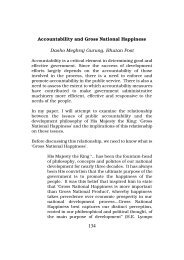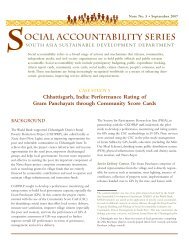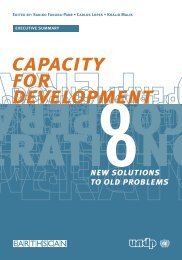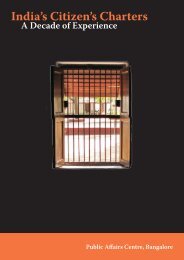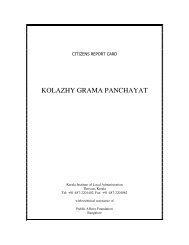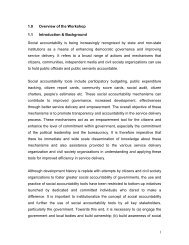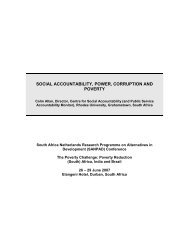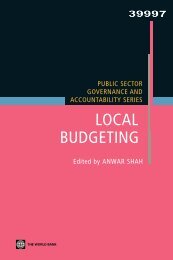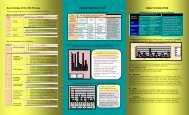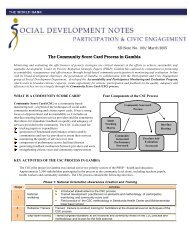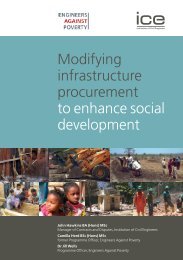Enabling Environment for Social Accountability in ... - SASANet
Enabling Environment for Social Accountability in ... - SASANet
Enabling Environment for Social Accountability in ... - SASANet
You also want an ePaper? Increase the reach of your titles
YUMPU automatically turns print PDFs into web optimized ePapers that Google loves.
plans, but there was no follow-up action taken by the GoM. Accord<strong>in</strong>g to the ORM, only 10 percent of<br />
sites have been restored follow<strong>in</strong>g m<strong>in</strong><strong>in</strong>g operations. The only response offered by the MRPA is that its<br />
M<strong>in</strong><strong>in</strong>g Department has set out an annual schedule of sites need<strong>in</strong>g restoration and a list of the associated<br />
costs, while conced<strong>in</strong>g that implementation has been weak (MRPA 2004).<br />
REPLICABILITY<br />
Currently Ivanhoe M<strong>in</strong>es Mongolia, Inc., and the GoM are negotiat<strong>in</strong>g a stability agreement to m<strong>in</strong>e the<br />
massive Oyu Tolgoi copper and gold deposit. Hence, the issues affect<strong>in</strong>g the Ongi River Bas<strong>in</strong> are likely<br />
to extend to other regions of the country, which are also beg<strong>in</strong>n<strong>in</strong>g to organize themselves <strong>in</strong> social<br />
movements and community-based organizations.<br />
One such organization is the Uuguul (“Native”) movement, established by dwellers of the South Gobi<br />
region <strong>in</strong> 2005 to oppose the government’s Stability Pact with Ivanhoe M<strong>in</strong>es, which allows Ivanhoe to<br />
reta<strong>in</strong> 95 percent of extracted m<strong>in</strong>erals. Uuguul also advocates re<strong>for</strong>m of the Mongolia M<strong>in</strong>eral Law to<br />
<strong>in</strong>clude stricter environmental standards <strong>for</strong> the m<strong>in</strong><strong>in</strong>g <strong>in</strong>dustry. The “movement <strong>for</strong> Giv<strong>in</strong>g Half of Oyu<br />
Tolgoi to Mongolians” (or the 50/50 Movement) is press<strong>in</strong>g <strong>for</strong> the equitable distribution of m<strong>in</strong>eral<br />
resources <strong>in</strong> Oyu Tolgoi. Toson Zaamar is a movement <strong>for</strong>med by herders to defend the sacred Barj<strong>in</strong><br />
Mounta<strong>in</strong> aga<strong>in</strong>st the activities of the Mongolian-Ch<strong>in</strong>ese m<strong>in</strong><strong>in</strong>g company, AshB. 77 These organizations<br />
have explicitly stated that they want “to br<strong>in</strong>g their voice to the government and demand [that] … the<br />
government leaves … their land alone” (<strong>in</strong>terview with Liberty Center, April 2005).<br />
Dur<strong>in</strong>g this study’s dissem<strong>in</strong>ation, the ORM chair listed several new and important developments <strong>in</strong> the<br />
growth of the Mongolian environmental movement. He cited the creation of “Calls <strong>for</strong> Khongor Aimag”<br />
to protect the aimag’s lakes and rivers <strong>in</strong> 12 soums; “Holy Stupor” [sic.] to protect Aokhon, Tamir, and<br />
Tarnili<strong>in</strong> Rivers <strong>in</strong> Arkhangai aimag; “Huvsgul Lake Dalai Movement” to protect Huvsgul Lake; “Ard<strong>in</strong><br />
Elch Peoples Missionaries” to protect rivers <strong>in</strong> Selenge aimag; and “GToson Daamar” <strong>in</strong> Tuv aimag to<br />
protect the Tuul River.<br />
The leaders of the ORM deserve much of the credit <strong>for</strong> <strong>in</strong>spir<strong>in</strong>g these movements, many of which they<br />
advise <strong>in</strong><strong>for</strong>mally and several of which they hope to <strong>in</strong>corporate <strong>in</strong>to an umbrella organization of<br />
environmental protection <strong>for</strong> Mongolia’s river systems. Their emergence <strong>in</strong>dicates the urgency of<br />
environmental concerns affect<strong>in</strong>g Mongolia’s watershed and the perception that if citizens do not act,<br />
m<strong>in</strong><strong>in</strong>g activities will cause serious environmental decl<strong>in</strong>e. Whether these organizations achieve ORM’s<br />
level of social accountability will depend upon their capacity to tap <strong>in</strong>to political and f<strong>in</strong>ancial resources,<br />
as well as their ability to network and coord<strong>in</strong>ate their activities (F<strong>in</strong>d<strong>in</strong>g ORM 7).<br />
FINDINGS AND RECOMMENDATIONS: THE ONGI RIVER MOVEMENT<br />
F<strong>in</strong>d<strong>in</strong>g ORM 1. Although access to significant and diverse resources, <strong>in</strong>clud<strong>in</strong>g extensive pro bono<br />
contributions, have been critical to the success of the ORM, there are cont<strong>in</strong>u<strong>in</strong>g concerns about its<br />
susta<strong>in</strong>ability and autonomy, especially <strong>in</strong> light of the limited resources they have been able to raise<br />
through membership dues.<br />
77 It has been suggested by various observers that the Zaamar movement’s campaign may be rooted more <strong>in</strong> economic concerns<br />
and the anti-Ch<strong>in</strong>ese and anti-Russian sentiments of disaffected N<strong>in</strong>ja m<strong>in</strong>ers than <strong>in</strong> purely environmental concerns.<br />
81




